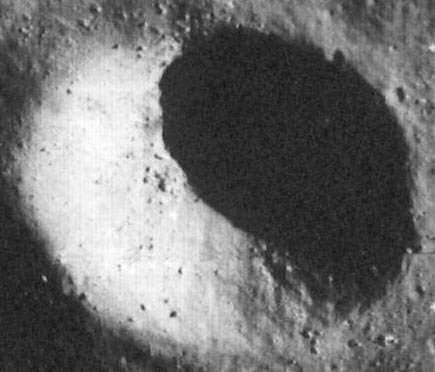 |
| Apollo 13 |
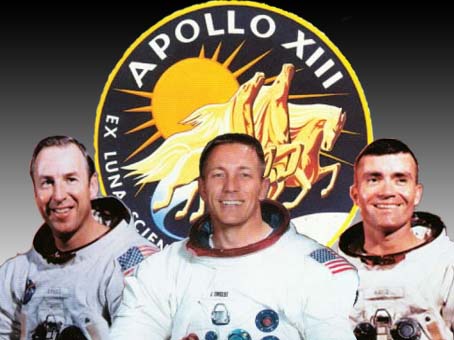 |
| The Third Lunar Landing |
| This web page sets out to explain the mission of Apollo 13 and what would have happened if the event 55 hours into the flight had not occurred. |
 |
| Three times space veteran James Lovell was joined on Apollo 13 by last minute CMP replacement Jack Swigert and LMP Fred Haise. |
| James Lovell Jack Swigert Fred Haise |
| Mission commander James Lovell describes how the crew patch was designed. "We started out designing this patch with the idea of the mythical god Apollo driving his chariot across the sky and dragging the sun with it. We gave this idea to an artist and he came up with the three horse design which symbolised the Apollo but also included the Earth and the moon. We decided to eliminate the names on the front and instead put in the Latin 'Ex Luna, scientia' or 'From the Moon, Knowledge'." |
 |
| At 2.13pm, on the 11th of April 1970, the massive Saturn V moon rocket carrying the crew of Apollo 13, left Pad 39A at the Kennedy Space Centre for the rocky surface of the moon at Fra Mauro. |
| After the successful missions of Apollo 11 and Apollo 12, Lovell and Haise were aiming to become the fifth and sixth men to explore the moon. |
 |
 |
| After a 77 hour journey, Apollo 13 swung into lunar orbit on April 14th and Fred Haise got his first close up look of the Moon's farside. |
| Haise "When we came up on the backside terminator in the command module, the colour I saw was a combination black to a reddish-brown to white mantling on some of those features." Swigert "My description would be dirty beach sand. It just looked greyish, a greyish brown, like a white sand that had gotten dirty." |
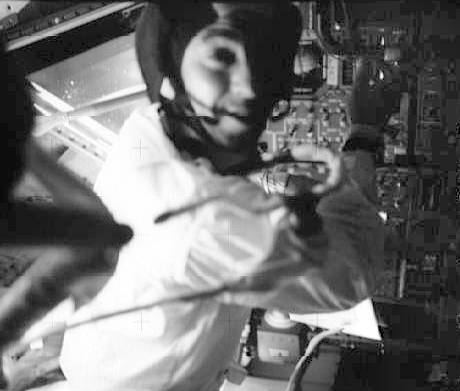 |
 |
| James Lovell seen inside the lunar module Aquarius just prior to PDI at GET 103 hours 31 minutes on April 15th. During his time on the Apollo 8 flight, Lovell had spotted a mountain he could use during his own landing on a later flight. He had said "One day, I thought, I'll be walking there." |
| After undocking the lunar module Aquarius began its descent to the point where the descent engine ignited and the landing phase began. |
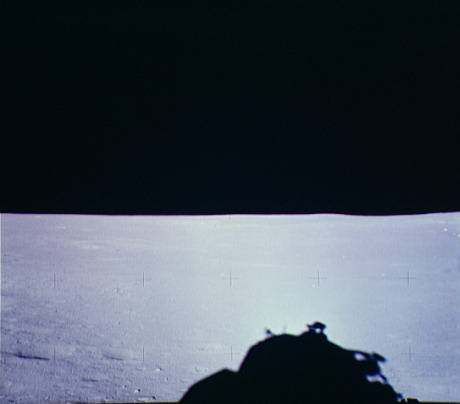 |
 |
 |
| On April 15th, after a successful landing on the Moon at 9.55pm EST, Fred Haise rests before the first of two periods of lunar surface activity. Lovell reads a checklist and enjoys the view of Fra Mauro out of the lunar module's window. |
| The First LEVA 16th April |
| Climbing down the last of the nine rungs on the lunar module's ladder, Lovell dropped the last few feet onto the landing pad. With one hand holding onto the ladder he put out his foot and stepped onto the Moon at 2.29am EST on the 16th April 1970. "We hope the knowledge we bring from the Moon, will help mankind to live in greater peace on the Earth." Turning his attention to his stability he noted that he had no trouble moving around and after a few minutes he had left the shadow of the Lunar Module and was collecting a small contingency sample in case an emergency forced the cancellation of the moonwalk. Returning to the lunar module he received the two lunar surface 70mm Hasselblad cameras from Haise. He then photographed the LMP as he descended the ladder to join him on the Moon just over ten minutes after Lovell had taken his first steps. |
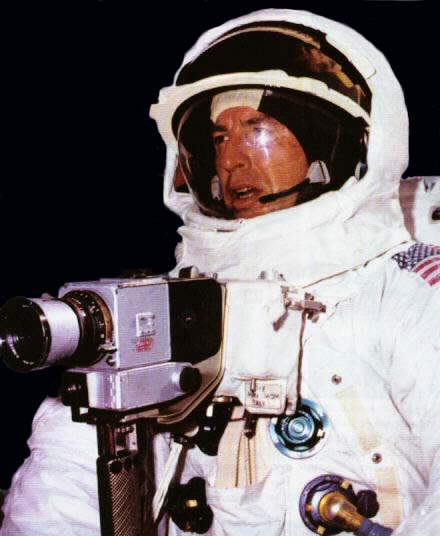 |
 |
| While Haise tested his footing, Lovell unstowed and deployed the large S-band antenna for voice relay, television coverage and lunar module telemetry to Earth. Collecting the TV camera Haise fixed it to its tripod and placed it about fifty feet away from the Lunar Module before climbing back into the ascent stage to switch over to the deployed antenna. After checking that the signal had been acquired by mission control, Lovell passed up the contingency sample, spare lithium hydroxide canisters and PLSS batteries, for later use, via the lunar equipment conveyor. After transferring down to Lovell the 16mm lunar geological exploration camera, Haise rejoined his commander on the surface. |
| While Lovell deploys the dish antenna, Haise can be seen at the MESA. |
 |
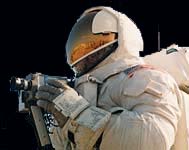 |
| With the colour TV showing the Earth bound audience the lunar surface activities, Lovell and Haise deploy the US flag on the Moon, they then posed for the customary photos, here Lovell can be seen with the flag as Haise records the moment. |
| After repositioning the TV camera, both men inspected and photographed the lunar module before beginning the main objective of this first moon walk at Fra Mauro. The RTG was fuelled, the ALSEP was attached to a carrying device and the hand tool carrier was loaded. Sample return container number 1 was unstowed, the lunar drill was collected and then the two men began their walk 500ft away from the lunar module out to the designated ALSEP deployment site. |
 |
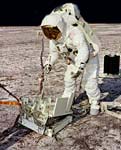 |
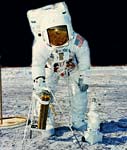 |
 |
 |
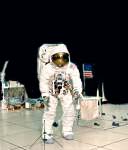 |
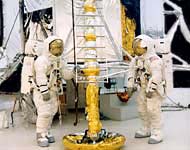 |
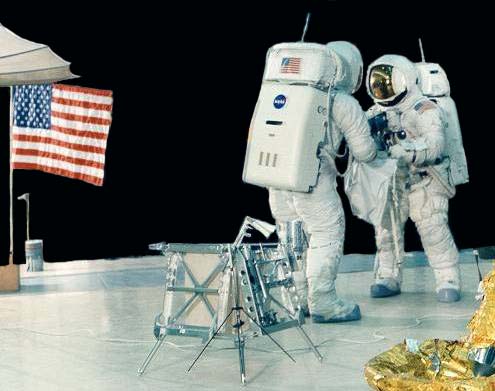 |
 |
 |
 |
 |
 |
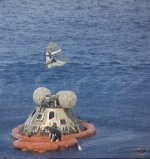 |
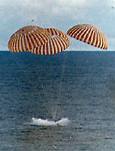 |
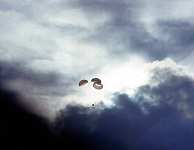 |
 |
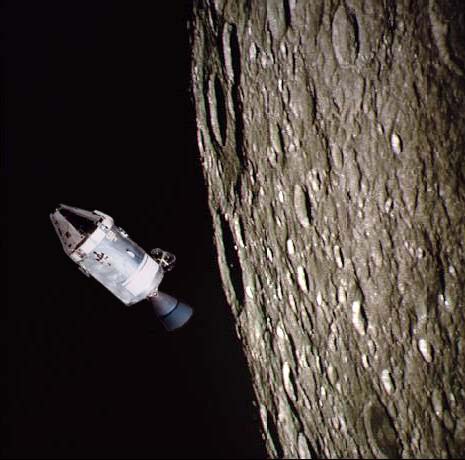 |
| Lovell carries the ALSEP. |
| Haise works with the lunar drill. |
| Lovell deploys one of the experiments. |
| After selecting the best location, Lovell connected the RTG cable and deployed the seismometer, the cold cathode gauge experiment, the charged particle lunar environment experiment and then activated the central station. |
| While Lovell was busy deploying the ALSEP, Haise assembled the lunar drill and then drilled two holes for the heat flow experiment. After deploying the probes into the two holes he then began the core sample collection with the help of Lovell. After photographs had been taken of the deployed experiments the astronauts checked the ALSEP site and checked the central station was correctly positioned before beginning the first geological traverse to Star Crater. |
| As Lovell and Haise walked along the undulating terrain around their landing site they commented on the surface's characteristics, stopping from time to time to photograph and collect rock samples. After a round trip of 5000ft the first moonwalk was at an end as the two men arrived back at their lunar module. |
| Fred Haise pauses to collect a rock sample. |
| Before climbing back into the lunar module, Haise deployed the Solar Wind Collector experiment, then it was time to end the LEVA after spending 4 hours and 42 minutes on the surface. |
| With Aquarius in the background, Haise carries the SWC to a safe distance for deployment. |
| The Second LEVA 16th April |
| After a rest period the two men were back on the Fra Mauro site for their second traverse, this time they hoped to climb to the edge of Cone Crater several hundred feet above the Lunar Module Aquarius. Cone Crater was blasted out by an impact and the scientists expected to gain valuable samples from around its rim. The two men had landed within walking distance of the crater in the hilly Fra Mauro highlands just 30 miles North of Fra Mauro Crater and due to their interest pre-flight in the geology of the mission they were in a good position to reach the rim. At GET 127 hours 58 minutes Lovell and then Haise descended the ladder into the brilliant sunlight to begin their second period of surface activity. This moonwalk would be dedicated to the second geological traverse across the surface and up the flank of Cone Crater with a few station stops along the way for photography, sampling and observations. After a few moments spent repositioning the TV camera the two men set off across the Moon towards the base of the crater towering above them in the distance. Briefly stopping for a trench sample and a second core sample they began their ascent of the crater noting that the soil here was getting deeper causing their boots to sink into it. Coming to a rise they reached the area of maximum elevation and there, standing in a small rock field, they looked around for the huge pit of Cone Crater hidden amongst the undulating and cratered rises on the flank. Luckily the two men had both been on the backup crew for Apollo 11 and could therefore devote more of their training time for Apollo 13 to geology. Unlike some other astronauts, they also considered the science of the mission just as important as the technical and flying side and so after studying their lunar surface maps they conferred with mission control who agreed to give them an extension to press on for the crater rim which the astronauts believed was only a few feet away. |
| Photos and sample gathering occupied the astronauts as they scaled Cone's flank. |
| Walking further on they suddenly saw the far side of Cone Crater and with excited voices they began the important work of geology sampling and recording at the rim. After completing all of their tasks Haise found a large boulder that he, in the best traditions of all geology field trips, pushed down into the crater with his foot sending it rolling to the bottom. |
| Lovell photographs Cone Crater from the rock field at lower right. |
| After a walk up the side of Cone Crater the two lunar explorers record the image of two rocks believed to be debris thrown up when the crater was formed. Using a hammer a rock chip was taken and placed in the sample bag for return to Earth. |
| Finally it was time to begin their walk back to the lunar module standing alone far off in the distance. After one final panoramic sequence the two men set off for Aquarius knowing that another major task had been accomplished. Lovell said of their geology work "We learned to be observers and to discuss what we saw. I think the training along this line is really taking a different curve toward what we're trying to get out of lunar geology." |
| Haise uses the close up camera to record the surface at Cone Crater. |
| Lovell, on the left, and Haise place their rock samples into storage for the return journey. |
| Back at the Lunar Module, after a walk of 8700ft, the two men begin close out duties for the last moonwalk of the mission. While Haise retrieves the SWC Lovell collects the final few samples for return. |
| At the end of their second moonwalk Lovell, on the left, and Haise unveiled the plaque on the front landing leg of their Lunar Module Aquarius to bring to a close their surface activities after a total of 4 hours and 43 minutes outside. |
| On the 17th April 1970 at GET 137 hours and 9 minutes the Lunar Module Aquarius bid farewell to Fra Mauro after a total stay time of 33 hours and 27 minutes. Carrying stowed equipment and 95lbs of lunar samples, most of which turned out to be fragmental breccia type rocks, Aquarius docked with the Command Module and the two moonwalkers were greeted by Jack Swigert who had been busy in lunar orbit photographing potential future landing sites. |
| Lovell's LEVA helmet. |
| After a total of 90 hours and 4 minutes in lunar orbit the crew ignited Odyssey's SPS engine and started their journey home. Once the crew were within the influence of the earth's gravity Haise commented, "We're on our way back home." |
| After a mission lasting 10 days and 1 hour the crew splashed down into the Pacific Ocean at 3.17pm EST. Ahead lay a 21 day period of quarantine in the LRL at Houston, but as the Command Module floated on the ocean Lovell turned to his fellow explorers and said, "Fellows, we're home". |
| Back To Index |
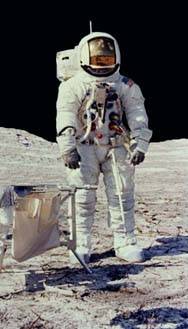 |
 |
 |
| Copyright 2000-2009 by Robert M. Southall |